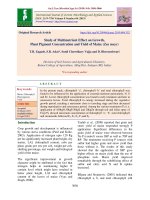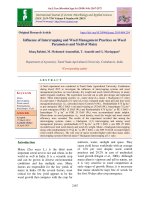Weed dynamics and productivity of hybrid maize (Zea mays) as affected by integrated weed management practices
Bạn đang xem bản rút gọn của tài liệu. Xem và tải ngay bản đầy đủ của tài liệu tại đây (111.59 KB, 6 trang )
Int.J.Curr.Microbiol.App.Sci (2018) 7(3): 2984-2989
International Journal of Current Microbiology and Applied Sciences
ISSN: 2319-7706 Volume 7 Number 03 (2018)
Journal homepage:
Original Research Article
/>
Weed Dynamics and Productivity of Hybrid Maize (Zea mays) as Affected
by Integrated Weed Management Practices
R. Nagasai Vardhan Naik1* and A. Velayutham2
1
Department of Agronomy, Agricultural College and Research Institute (AC&RI),
Killikulam, India
2
Department of Farm Management, AC&RI, Killikulam, Tamil Nadu, India
*Corresponding author
ABSTRACT
Keywords
Economics, Herbicides,
Integrated weed
management, Maize,
yield
Article Info
Accepted:
24 February 2018
Available Online:
10 March 2018
A field experiment was conducted during Rabi season of 2015-2016 at Agricultural
College and Research Institute, Killikulam to find out the most effective weed control
measure study weed dynamics, productivity and economics of hybrid maize as affected by
integrated weed management. None of the pre-emergence herbicides alone provided
desired control of weeds. However, inclusion of one hand weeding at 30 DAS with preemergence herbicides markedly improved weed control efficiency (WCE), yield attributes,
grain and stover yield. Alachlor @ 1.5 kg a.i./ ha + HW at 30 DAS proved most effective
in controlling weeds (WCE 90.33%) followed by two hand weedings at 15 and 30
DAS(WCE 84.08%) and they reduce the weed density and weed biomass significantly,
which in turn increased yield compared with unweeded control. Significantly highest grain
yield were recorded underalachlor @ 1.5 kg a.i./ ha + HW at 30 DAS (7115 kg ha-1)
followed by two hand weedings at 15 and 30 DAS (6855 kg ha -1) and mechanical weeding
with power weeder twice on 15 and 30 DAS(6714 kg ha -1). The highest net returns and
highest benefit: cost ratio were obtained under alachlor @ 1.5 kg a.i./ ha + HW at 30 DAS
followed by two hand weedings at 15 and 30 DAS.
Introduction
Maize (Zea mays L.) is an important cereal
crop of India. The grains of maize are used in
a variety of ways by the human beings.
Recently, with the release of improved
cultivars and hybrids, the grain yield has been
increased but still the maize crop faces many
problems. Farmers usually give prime
importance to few cultural practices and
neglect other factors like seed rate and weed
control. Maize crop gets infested with variety
of weeds and subjected to heavy weed
competition, which often inflicts huge losses
ranging from 28 to 100 % (Patel et al., 2006).
Weed management strategies attempt to limit
the deleterious effects of weeds growing with
crop plants. These effects could be quite
variable, but the most common is competition
for available resources. The quantities of
growth factors used by weeds are thus
unavailable to the crop. The extent of nutrient
loss varies from 30-40 % of the applied
nutrients (Mundra et al., 2002). Hence,
2984
Int.J.Curr.Microbiol.App.Sci (2018) 7(3): 2984-2989
suitable weed control strategies in maize can
be the sequential use of pre-emergence and
post-emergence herbicides or a pre-emergence
herbicide application followed by two hand
weedings or intercultural operation with
power weeder so that the crop is protected
well against the weeds during the critical
period of crop weed competition. Atrazine,
alachlor and pendimethalin are widely used
for control of weeds in maize. But their
continuous use for long time may lead
development of herbicide resistance in weeds
(Pandey et al., 2000). Hence, there is a need to
develop integrated weed management
strategies for effective weed control and to
realize higher maize productivity.
Materials and Methods
The field experiment was conducted
duringRabi season of 2015-2016 at
Department of farm management, Agricultural
College farm, Agricultural College and
Research
Institute,
Killikulam.
The
experimental field is geographically located in
the southern part of Tamil Nadu at 8°46'
North latitude and 77° 42' East longitude at an
altitude of 40 meters above mean sea level.
The experimental site was sandy clay loam,
0.34% organic carbon, neutral in reaction (pH
7.28), low in available N (198 kg ha-1), low in
available P (10.1 kg ha-1) and medium in
available K (139 kg ha-1).
The experiment was laid out in a randomized
block design with three replications. The gross
plot size was 5 x 3.6 m and net plot size was
4.5 x 3.1 m. A set of nine twelve treatments
comprising T1 - Alachlor @ 1.5 kg a.i ha-1, T2 Alachlor @ 1.5 kg a.i ha-1 + one hand weeding
on 30 DAS, T3 - Alachlor @ 1.5 kg a.i ha-1 +
one mechanical weeding with power weeder
on 30 DAS, T4 - Atrazine @ 0.25 kg a.i ha-1,
T5 - Atrazine @ 0.25 kg a.i ha-1 + one hand
weeding on 30 DAS, T6 - Atrazine @ 0.25 kg
a.i ha-1 + one mechanical weeding with power
weeder on 30 DAS ; T7 - Pendimethalin @
0.75 kg a.i ha-1, T8 - Pendimethalin @ 0.75 kg
a.i ha-1 + one hand weeding on 30 DAS, T9 Pendimethalin @ 0.75 kg a.i ha-1 + one
mechanical weeding with power weeder on 30
DAS, T10 - Hand weeding twice on 15 and 30
DAS, T11-Mechanical weeding with power
weeder twice on 15 and 30 DAS, T12 Unweeded control. Maize hybrid COH (M) 6
sown with a spacing of 60 x 25 cm. Crop was
fertilized with 250:75:75 Kg NPK ha-1 through
urea, single super phosphate and muriate of
potash respectively.
Thinning was done at 15 DAS to maintain
plant to plant distance of 25 cm. Thinning was
done at 10 DAS to maintain plant to plant
distance of 25 cm. All the herbicides dissolved
in water (500 L ha-1) were sprayed as preemergence on the next day of sowing.
Results and Discussion
Weed flora
The predominant weed species observed in the
experimental field were Cyperus rotundus
among sedges, Cynodon dactylon among
grasses and Digeraarvensis, Trianthema
portulacastrum,
Cleome
viscosa
and
Phyllanthus niruri among broad-leaved
weeds. Among all the three weed groups, the
most predominant weed species observed was
Cyperus rotundus.
Plant height, leaf area index and dry matter
production
Highest plant height, leaf area index and dry
matter production was noticed with alachlor
@ 1.5 kg a.i ha-1 with one hand weeding on 30
DAS (T2) which was however, on par with
hand weeding twice on 15 and 30 DAS (T10)
(Table 1). This might be due to lesser weed
infestation as evident from lower weed dry
matter.
2985
Int.J.Curr.Microbiol.App.Sci (2018) 7(3): 2984-2989
Table.1 Growth and yieldof hybrid maize as influenced by different weed management practices
Treatments
Plant
height
(cm) at
harvest
221.0
LAI
(60
DAS)
Crop Growth
Rate (kg ha-1
day-1) (30-60
DAS)
212.7
Grain
yield (kg
ha-1)
4.03
Dry matter
production
(kg ha-1) at
harvest
15970
T2 - Alachlor @ 1.5 kg a.i ha-1+ one hand weeding on 30 DAS
244.6
4.46
17660
235.2
7115
T3 - Alachlor @ 1.5 kg a.i ha-1+ one mechanical weeding with power
weeder on 30 DAS
T4 - Atrazine @ 0.25 kg a.i ha-1 (PE)
226.7
4.13
16350
217.7
6584
205.1
3.74
14780
196.7
5959
T5 - Atrazine @ 0.25 kg a.i ha-1+ one hand weeding on 30 DAS
228.4
3.90
15430
207.7
6218
T6 - Atrazine @ 0.25 kg a.i ha-1+ one mechanical weeding with power
weeder on 30 DAS
T7 - Pendimethalin @ 0.75 kg a.i ha-1 (PE)
208.2
3.80
15040
200.3
6053
208.6
3.50
13870
184.0
5581
T8 - Pendimethalin @ 0.75 kg a.i ha-1+ one hand weeding on 30 DAS
T9 - Pendimethalin @ 0.75 kg a.i ha-1+ one mechanical weeding with
power weeder on 30 DAS
T10 - Hand weeding twice on 15 and 30 DAS
199.5
196.4
3.63
3.58
14380
14170
191.2
189.2
5793
5711
235.7
4.30
17020
226.2
6855
T11 - Mechanical weeding with power weeder twice on 15 and 30 DAS
T12- Un weeded control
SEd
CD (p=0.05)
231.0
170.7
5.5
11.5
4.21
3.12
0.39
0.81
16660
12340
402
832
221.7
164
5.4
11.1
6714
4967
162
335
T1 - Alachlor @ 1.5 kg a.i ha-1 (PE)
2986
6431
Int.J.Curr.Microbiol.App.Sci (2018) 7(3): 2984-2989
Table.2 Weed dynamics and weed control efficiency of hybrid maize as influenced by different weed management practices
Treatments
T1 - Alachlor @ 1.5 kg a.i ha-1 (PE)
T2 - Alachlor @ 1.5 kg a.i ha-1+ one hand weeding on 30 DAS
T3 - Alachlor @ 1.5 kg a.i ha-1+ one mechanical weeding with power weeder
on 30 DAS
T4 - Atrazine @ 0.25 kg a.i ha-1 (PE)
T5 - Atrazine @ 0.25 kg a.i ha-1+ one hand weeding on 30 DAS
T6 - Atrazine @ 0.25 kg a.i ha-1+ one mechanical weeding with power weeder
on 30 DAS
T7 - Pendimethalin @ 0.75 kg a.i ha-1 (PE)
T8 - Pendimethalin @ 0.75 kg a.i ha-1+ one hand weeding on 30 DAS
T9 - Pendimethalin @ 0.75 kg a.i ha-1+ one mechanical weeding with power
weeder on 30 DAS
T10 - Hand weeding twice on 15 and 30 DAS
T11 - Mechanical weeding with power weeder twice on 15 and 30 DAS
T12- Un weeded control
SEd
CD (p=0.05)
*Data not statistically analysed
2987
Weed
Weed dry
density
matter (kg
(No. m-2)
ha-1)
42.61
475.1
(6.57)
31.46
186.0
(5.65)
27.24
447.3
(5.27)
46.58
681.4
(6.86)
24.41
583.6
(4.99)
28.97
647.2
(5.43)
49.64
862.4
(7.08)
24.78
780.3
(5.03)
28.54
836.6
(5.39)
20.87
394.6
(4.62)
44.36
418.2
(6.70) 1756.2
134.35
(11.61)
0.34
1.05
0.70
2.19
*Weed control
efficiency (%)
80.48
90.33
82.79
69.65
73.71
71.69
64.89
66.34
63.55
84.08
83.59
-
-
Int.J.Curr.Microbiol.App.Sci (2018) 7(3): 2984-2989
The LAI (leaf area index) and CGR (crop
growth rate) increased upto 90 DAS and
declined there after marginally due to
senescence. Alachlor @ 1.5 kg a.i ha-1 with
one hand weeding on 30 DAS (T2) created
weed free environment, reduce weed density
and biomass, which would have favoured the
crop to grow well, producing more
photosynthetic area, which ultimately lead to
higher LAI and CGR. Better stature of crop,
as reflected by taller plants, higher LAI and
CGR
would
have
enhanced
the
photosynthesis, which in turn resulted in
higher dry matter production (Table 1).
Grain yield
The highest grain yield was recorded with
alachlor @ 1.5 kg a.i ha-1 as pre-emergence
with one hand weeding on 30 DAS (Table 1),
which was in parity with hand weeding twice
on 15 and 30 DAS. This was due to lesser
crop weed competition for growth resources
throughout the crop growth period and
availability of congenial environment for
better expression of growth and yield
potential. Similar findings were reported by
Pandey et al., (2001), Sunitha et al., (2011)
and Sandhya Rani and Karuna Sagar (2013).
Heavy weed infestation in control (T12) had
deprived the crop for all the growth resources
and resulted in poor performance of corn
(Table 1).
Weed density, dry matter and weed control
efficiency
Weed population and dry weight were
significantly reduced due to all weed-control
treatments compared with the weedy check.
Among the various weed management
practices, the lowest weed population and dry
weight were recorded under alachlor @ 1.5 kg
a.i ha-1 with one hand weeding on 30 DAS
(T2) (Table 2). This indicated that sequential
application of herbicides has reduced the
weed density compared to the application of
pre-emergence herbicides alone. Hand
weeding twice on 15 and 30 DAS (T10) is at a
par with T2 treatment (Table 2). Lower weed
dry matter was noticed at all the stages of
crop growth. Removal of weeds that
germinated along with crop during the first
hand weeding and removal of weeds that
germinated afterwards during the second hand
weeding and smothering of weeds by crop
thereafter could be attributed to this.
Invariably unweeded control (T12) registered
highest total weed population and dry weight
with maximum grass, sedge and broad leaved
weed populations (Table 2). The current
results are in conformity with the findings of
Pandey et al., (2000), Maliya and Singh
(2007).
Weed-control efficiency (WCE) of different
treatments varied from 63.55-90.33%. Among
all the treatments, alachlor @ 1.5 kg a.i ha-1
with one hand weeding on 30 DAS (T2) was
the most effective in controlling the weeds
(WCE 90.33%), followed by hand weeding
twice on 15 and 30 DAS(T10)(WCE 84.08%)
(Table 2). This could be attributed to the weed
free condition achieved during the critical
period of crop growth with two hand
weeding. Weed control efficiency recorded
with pre-emergence application of atrazine
with one hand weeding was high at all the
stages of crop growth. This could be due to
the fact that the initial weed population was
effectively controlled by persistence activity
of pre-emergence application of atrazine. The
results are in line with the findings of Malviya
et al., (2012), Mundra et al., (2002),
Selvakumar and Sundari (2006) and Kamble
et al., (2005).
References
Kamble, T.C., S.U. Kakade, S.U. Nemade,
R.V. Pawar and V.A. Apotikar. 2005.
2988
Int.J.Curr.Microbiol.App.Sci (2018) 7(3): 2984-2989
Integrated weed management in maize.
Crop Res., 29(3): 396-400.
Malviya, A. and B. Singh. 2007. Weed
dynamics, productivity and economics
of maize (Zea mays) as affected by
integrated weed management under
rainfed conditions. Indian J. Agron.,
52(4): 321-324.
Malviya, A., N. Malviya, B. Singh and A.K.
Singh.
2012.
Integrated
weed
management in maize (Zea mays) under
rainfed conditions. Indian J. Dryland
Agric. Res. Development, 27(1): 70-73.
Mundra, S.L., A.K. Vyas and P.L. Mailwal.
2002. Effect of weed and nutrient
management on nutrient uptake by
maize and weeds. Indian J. Agron.,
43(3): 378-383.
Pandey, A.K., V. Prakash, R.D. Singh and
V.P. Mani. 2000. Effect of herbicides
mixtures and cultural practices on maize
and associated weeds under mid hills of
N-W Himalayas. Annals of Agric. Res.,
21(1): 58-64.
Pandey, A.K., V. Prakash, R.D. Singh, R.D
and V.P. Mani. 2001. Integrated Weed
Management in maize (Zea mays).
Indian J. Agron., 46(2): 260-265.
Sakthivel, N., M. Revathi and S. Bhuvana
Devi. 2014. Effect of the tillage and
weed management in maize and
sunflower cropping system. Biennial
Conference of Indian Soc. Weed Sci.,
pp.200.
Sandhya Rani, B and G. Karuna Sagar. 2013.
Effect of integrated weed management
on growth, yield and economics of
sweet corn. Agric. Sci. Digest, 33(1):
52-55.
Selvakumar, T and A. Sundari. 2006. Effect
of intercropping systems and weed
management practices on weeds in
maize (Zea mays). Indian J. Weed Sci.,
38(1&2): 133-134.
Sunitha, N., P. Maheswara Reddy and D.S.
Reddy. 2011. Influence of planting
pattern and weed control practices on
weed growth, nutritive uptake and
productivity of sweet corn. Crop
Research. 41 (1, 2 & 3): 13-20.
How to cite this article:
Nagasai Vardhan Naik, R. and Velayutham, A. 2018. Weed Dynamics and Productivity of
Hybrid Maize (Zea mays) as Affected by Integrated Weed Management Practices.
Int.J.Curr.Microbiol.App.Sci. 7(03): 2984-2989. doi: />
2989
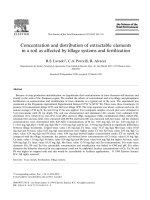
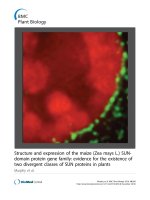
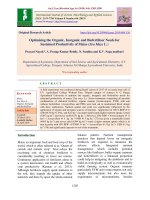
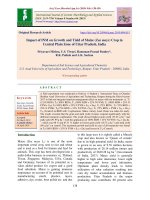
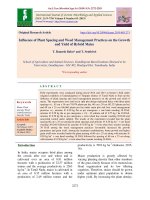
![Growth and yield of Ashwagandha [Withania somnifera (L.)] as influenced by different intercropping system in Kymore plateau of Madhya Pradesh](https://media.store123doc.com/images/document/2020_01/09/medium_vsb1578562778.jpg)
